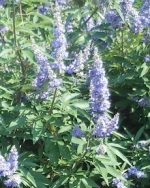 Also called monk’s pepper, chaste tree is a sprawling deciduous shrub a native to the Mediterranean region and western Asia where it grows in moist soil such as those along streams. After being introduced into the US it naturalized and has become invasive in some areas from Pennsylvania and Oregon, south to Florida, Texas, and California. Plants grow 8-20’ tall and have palmately compound leaves with 5-7 lanceolate leaflets up to 6” long and are aromatic and grayish green. The small summer blooming flowers are lavender to light violet or white and are carried in loose panicles up to 12” long. They are fragrant and attract butterflies. Chaste tree has been used in foundation plantings, shrub borders, cottage gardens and butterfly gardens, and as hedges and screens. USDA Hardiness Zones 6-9
Also called monk’s pepper, chaste tree is a sprawling deciduous shrub a native to the Mediterranean region and western Asia where it grows in moist soil such as those along streams. After being introduced into the US it naturalized and has become invasive in some areas from Pennsylvania and Oregon, south to Florida, Texas, and California. Plants grow 8-20’ tall and have palmately compound leaves with 5-7 lanceolate leaflets up to 6” long and are aromatic and grayish green. The small summer blooming flowers are lavender to light violet or white and are carried in loose panicles up to 12” long. They are fragrant and attract butterflies. Chaste tree has been used in foundation plantings, shrub borders, cottage gardens and butterfly gardens, and as hedges and screens. USDA Hardiness Zones 6-9
The following natives are recommended as alternatives:
Bottle-Brush Buckeye (Aesculus parviflora)
This broad to rounded deciduous shrub grows up to 8’ tall and has coarse palmately compound leaves with five to seven oblong leaflets that turn yellow to gold in the fall. The fuzzy white flowers are sweetly fragrant and appear in upright spikes in summer. Native to open woods, floodplains, and woodland edges in central Alabama and adjacent Georgia. USDA Hardiness Zones 4-9
Red Buckeye (Aesculus pavia)
A deciduous clump-forming shrub or small tree, red buckeye grows up to 20’ tall and has dark red flowers in 4-10” long panicles in early summer. The shiny dark green leaves are palmately compound with 5 leaflets that are 4-6” long. Plants are native to wooded slopes, along streams, and in wooded valleys from North Carolina to Illinois, south to Florida and Texas. USDA Hardiness Zones 4-8
Wild Indigo (Amorpha fruticosa)
Wild indigo is a deciduous shrub native to moist open woodlands, floodplains, streambanks and swamp margins from New York to North Dakota, south to Florida and Texas, west to California. It grows 4-12’ tall and has pinnately compound leaves with 11-35 spine tipped gray-green leaflets up to 2” long. The small tubular purple flowers have showy orange-yellow anthers and are carried in dense racemes in late spring to early summer. USDA Hardiness Zones 4-9
American Beautyberry (Callicarpa americana)
Growing 6-8’ tall, this loose open deciduous shrub has outstanding clusters of purple berries in late autumn and early winter. The summer blooming flowers are pink to lavender and insignificant. The leaves are coarse, toothed, and up to 8” long. Native to meados, dunes, and open, well-drained woodlands from Virginia ad Missouri, south to Florida and Texas. USDA Hardiness Aones 6-10
California /WildLilac (Ceanothus thyrsiflorus)
California lilac is an evergreen shrub or small tree growing 4-12’ tall and wide. It has billowing clusters of blue flowers in spring and early summer, and is native to open woods and chaparral in coastal mountains from southern California north to southern Oregon. USDA Hardiness Zones 7-10
Fringe Tree (Chionanthus virginicus)
Flat clusters of creamy-white flowers appear in the spring on this small to medium sized deciduous tree and are followed by yellow to red fall color. Native to New Jersey, Kentucky, and Missouri, south to Florida and Texas, fringe tree grows in woodland edges, rock outcroppings, and roadsides. USDA Hardiness Zones 4-9
Summersweet (Clethra alnifolia)
With strongly scented creamy white spikes of flowers in summer and decorative dried capsules in winter, this deciduous shrub grows up 4-8’ tall and wide and has deep green quilted foliage. Native to swamps low woods, floodplains, and pond margins on the coastal plain and outer piedmont from Maine south to Florida, west to Texas. USDA Hardiness Zones 4-9
Georgia Plume (Elliotta racemosa)
Also called summer plume, this deciduous shrub or small tree grows up to 35’ tall and has 3-4” long bright green leaves that turn red in the fall and racemes of 4-5 petaled white flowers in late spring to early summer. It is endemic to Georgia where it grows in habitats from moist to dry. Low seed production and resistance to transplanting have made the plant scare in both cultivation and the wild. USDA Hardiness Zones 7-9
Mountain Witch Alder (Fothergill major)
With fragrant white bottlebrush spikes of flowers, this deciduous shrub grows 6-10’ high and has dark green leaves that turn shades of yellow, orange, and red-purple in fall. It is native to mountain woods, ravines, and along stream banks in the southern Appalachians of North Carolina, Georgia, and Alabama. USDA Hardiness Zones 4-8
Southern Wax Myrtle (Morella cerifera aka Myrica cerifera)
Growing up to 15’ tall, southern wax myrtle is an evergreen large shrub or small tree and is native to wetlands, riparian sites, sand dunes, fields, hillsides, and pine barrens from New Jersey south to Florida, west to the lower Mississippi Valley and Texas. It has aromatic olive green leaves and fragrant but non-showy flowers. USDA Hardiness Zones 7-10
Sourwood (Oxydendrm arboretum)
Pendent clusters of fragrant bell-shaped white flowers appear in summer on this small to medium sized deciduous understory tree. Crimson red foliage in the fall provides additional interest.. Native to Pennsylvania west to Indiana and south to Florida and Louisiana. USDA Hardiness Zones 5-9